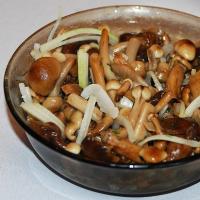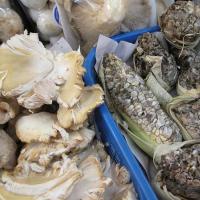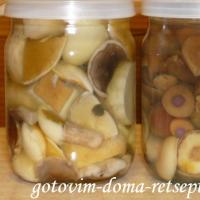Cap mushrooms: structure, functions, examples
A huge variety of different mushrooms grows on Earth, edible and inedible, poisonous and useful. More familiar and well-known are hat mushrooms. Read about their functions, structure and parameters in the article.
What are cap mushrooms?
This concept combines fungi that have similar features, functions and body structure. The group "cap mushrooms" is represented by both edible and useful, and inedible and poisonous species.
They are endowed with hats and legs. But not all. In some species, the body of the fetus is formed by only one hat in the form of an irregularly shaped growth. Habitual and popular for humans are hat mushrooms such as porcini, chanterelles, milk mushrooms and others.
The structure of mushrooms
The structure of the cap mushroom of a huge natural kingdom is simple. It has a fruiting body formed by a cap and a stem. The main part of the fungus is the mycelium located in the soil. It is called mycelium, which is a white branching thread. Mycelial cells have two nuclei.

The structure of the cap mushroom is such that the cap with the stem consists of threads that are tightly connected to each other. At the leg they are the same, and in the hat they form the upper and lower layers. The surface of the upper layer is covered with skin of different colors. The lower layer of some mushrooms, for example, butterdish, boletus or white, has tubules. They are called tubular mushrooms. In plants such as mushrooms, volnushki and russula - plates, respectively, mushrooms are called lamellar.
edible mushrooms
To date, four thousand cap varieties of mushrooms are known, and only a few hundred of them are edible. There are mushrooms that are suitable for consumption only when they are processed by salting, boiling, drying. They are called inedible, but they should not be confused with poisonous ones. Edible cap mushrooms are conditionally divided into four groups:
- White mushroom, real breast, camelina.
- Butter dish, boletus, champignon, boletus, volnushka.
- Mokhovik, black breast, morel, chanterelle, autumn honey agaric.
- Russula, talker, oyster mushroom, umbrella mushroom.
Porcini
It is called a boletus, but it has nineteen more names. The porcini mushroom is the king of the mushroom community. It is edible, has a high nutritional value, pleasant aroma and excellent taste, for which it is appreciated by culinary specialists.

Mushrooms grow up to thirty centimeters in height and more. The hat is light yellow or dark brown, depending on the place of growth and age of the fungus.
It grows everywhere, with the exception of forests with a predominant majority of aspen and alder. It grows everywhere in Eurasia, North America, less often in Lebanon and Syria. There are many boletus mushrooms in Russia, especially in young forests.
Chanterelles
These mushrooms are edible, they are so called because of the color. She is bright red. In nature, chanterelles of a pale yellow color are found. Mushrooms prefer to grow at night, where they were not there the day before.
There are many varieties of this fungus in nature. In Russian forests, the most popular are ordinary (real), yellow, tubular, funnel-shaped chanterelles. The place of growth are swampy hummocks of deciduous and coniferous forests. Particular preference is given to areas with low herbage. Chanterelles love to grow in large groups.
poisonous mushrooms
They differ from edible ones in the presence of poisonous substances called toxins. Their use is fraught with serious poisoning, and in many cases, poisonous cap mushrooms cause death. The nature of poisoning is different, on this basis, poisonous mushrooms are divided into three groups:
- Food poisoning.
- Poisoning, as a result of which the activity of the nervous system is disrupted.
- Poisoning leading to death.
gall fungus
It is a type of poisonous mushroom. It is also called false white fungus or mustard. Prefers coniferous forests and sandy soil. It is rare, from July to October.
The cap diameter reaches ten centimeters, it is dry and smooth. It comes in brown or brown. In young mushrooms, it is convex, and in old ones it gradually acquires a plano-convex shape.

The thick pulp is soft, white, and pinkish on the cut. It is odorless and bitter in taste. The leg of medium length and thickness has a creamy ocher color. It is covered with a dark brown mesh pattern. The poisonous mushroom has an external resemblance to a boletus.
Death cap
This mushroom is called fly agaric white and green. It is the most dangerous of all poisonous mushrooms. Prefers broad-leaved, coniferous, birch forests and oak forests. Grows in groups and singly from June until frost. You can rarely meet him.
The hat is 10 cm in diameter. In young mushrooms, it has a white or grayish color, while in old specimens it is grayish-green. The thin pulp is white in color, taste and smell are absent. The stem is long, straight and thin. Inside is hollow. It has a white color with a yellowish tint and a striped ring.
This mushroom is deadly poisonous. In case of poisoning, the first signs appear after 8-12 hours. But sometimes much later, after 20-40 hours after eating mushrooms.
Reproduction of cap mushrooms
This process is carried out by spores with great endurance. Their shell is thick. It performs the function of protecting spores from overheating during periods of intense heat, and hypothermia during winter cold. Such reproduction is called asexual.
The fruit bodies at the bottom have plates or tubes that increase the surface that light, small spores need for their formation. When the spores enter the optimal environment, they begin to germinate into hyphae. Due to their growth and branching, mycelium (mycelium) is formed - the vegetative part of the fungus, which can be in this state for a long time. Reproduction occurs when spores are formed in the fruiting body.

Hat mushrooms form a body in late summer or early autumn. But this does not apply to morels and lines, which are spring mushrooms. When the spores mature, they begin to crumble and spread by wind, insects or animals over long distances. In most fungi, the mycelium has cells with a binuclear structure, which, after fusion, contribute to the growth of the mycelium and the formation of new fruiting bodies.
Nutrition
Varieties of cap mushrooms feed on ready-made substances of organic origin, which are taken from their environment. It happens like this: the mycelium absorbs nutrients from the soil, causing the forest floor and wood to decompose. Organic substances are formed that feed on the body of the fungus.
In many species, the mycelium with its numerous threads braids the roots of shrubs and trees, penetrates inside and forms mycorrhiza (fungal root). So water with a mineral content in it is absorbed by the mycelium and nourishes the fruiting body. This way of feeding is characteristic of mycorrhizal fungi.
Examples of hat mushrooms of this variety are almost their entire large group with a tubular structure of the lower body of the fetus: pigs, fly agaric, chanterelles, milk mushrooms, russula, mushrooms and others.
The formation of mycorrhiza in one fungus occurs with one tree species, and in another - with several. In porcini fungus, partners are spruce, oak, pine, birch, in camelina - pine and spruce, in boletus - birch, spruce and pine. But the deciduous butter dish has only one partner - larch, the black mushroom and the twig have a birch. From here the main function of mushrooms is determined - providing food for tree species: aspens, birches, pines, spruces and others. Without fungi involved in the formation of mycorrhiza, trees cannot develop normally.

Another, no less important function is that saprophytic fungi, which are the majority of cap varieties, are involved in the decomposition of dead herbaceous and woody plant remains. As a result of this process, organic substances are converted into minerals. They are well absorbed by plants and processed again into organic ones.
The third function is that the rotted litter ensures the normal existence of the forest. It is formed by mushrooms, being part of its large community. In the forest, mushrooms are not superfluous. Instances unnecessary for man are necessary for the forest. Therefore, you should not destroy, compact and trample the litter in which the mycelium is located. Its absence is the main reason for the destruction of forests.
How to grow mushrooms?
The fruit body of edible mushrooms contains a large amount of useful and nutritious substances. For this reason, they are grown artificially. Hat mushrooms are very popular for breeding.

Special workshops are built with shelving in several tiers. They are filled with well-fertilized soil, into which the mycelium is planted. The workshops are constantly monitored for temperature and humidity. Optimum conditions are maintained for the rapid germination of fruiting bodies. On a plot area of one square meter, twenty kilograms of mushrooms can be grown. Within one year, the crop is harvested five times.
The use of mushrooms
Edible mushrooms have been used for food for a long time, when people were still gathering. They were boiled, salted, dried. Currently, first courses are prepared from mushrooms, they are used in salads, to decorate dishes, in sauces and seasonings.
Hat varieties are widely used in medicine using folk methods of treating diseases. White mushroom is applied to frostbitten parts of the body. On the basis of false mushrooms, a laxative is prepared, and from a pepper mushroom - a medicine against tuberculosis. Pale grebe in meager doses treats cholera.



